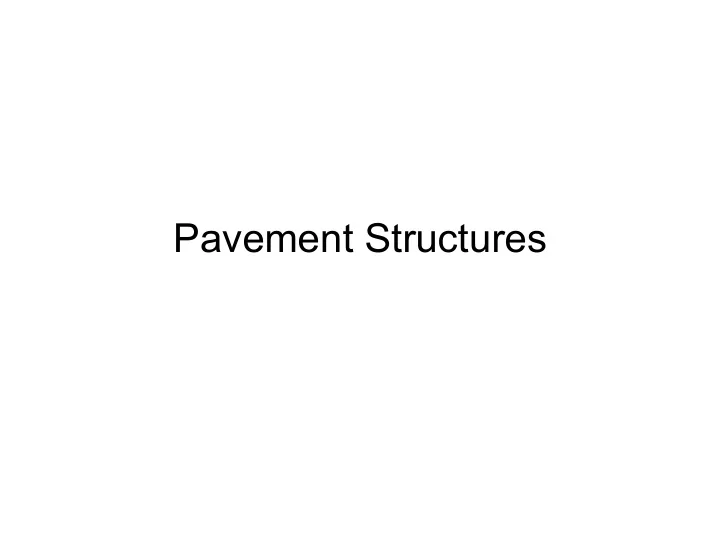

Pavement Structures
Life without Pavements CIVL 3137 2
Pavements The function of a pavement structure is to distribute the imposed wheel loads over a large area of the natural soil underneath the pavement so the stresses in the soil remain low. Without the pavement, shear failure would occur in the wheel paths and deep ruts would form. The pavement also provides for a smooth travelling surface so the ride is comfortable and safe. CIVL 3137 3
Pavements Pavements are broadly classified as either “flexible” or “rigid” depending on how they distribute the loads to the underlying soil. Rigid pavements are surfaced with portland cement concrete. The rigidity of the pavement slabs prevents the slab from bending too much under load, which keeps the stresses in the underlying soil low. CIVL 3137 4
Rigid Pavements Rigid pavements act like beams. When you apply a load in the middle of a beam, the beam deflects. The amount of deflection depends on the magnitude of the load and the thickness and stiffness of the beam. Unlike a simply-supported beam, though, the rigid pavement slab is supported by the ground underneath it and the ground itself helps to resist bending of the slab. CIVL 3137 7
Rigid Pavements We often model a rigid pavement as a slab resting on an infinite number of tiny springs. The more the slab bends, the more the springs compress. As the springs compress, they push back on the slab with a force proportional to the spring deflection. So the more the slab bends, the harder the ground pushes back, which helps to limit the amount of bending. CIVL 3137 8
Rigid Pavements “Simply supported beam” CIVL 3137 9
Rigid Pavements “Beam on elastic foundation” CIVL 3137 10
Rigid Pavements Pa “Beam on elastic foundation” CIVL 3137 11
Rigid Pavements CIVL 3137 12 Source: WSDOT Pavement Guide Interactive CD-ROM
Rigid Pavements Most rigid pavements are constructed by compacting the natural soil to make it firm (increase the spring constant), then laying down a layer of gravel or crushed stone called the subbase . The concrete slab is then poured on top of the subbase. The subbase is mainly there to drain any water that gets into the pavement system off to the sides of the road so it doesn’t weaken the underlying soil. CIVL 3137 13
Rigid Pavement Structure CIVL 3137 15
Flexible Pavements Flexible pavements include pavements surfaced with asphalt concrete as well as unsurfaced (gravel) roads. Flexible pavements distribute the wheels load over a broad area through grain-to-grain contact between aggregate particles. The further you go below the surface of the pavement, the more particles become involved in carrying the load, so the lower the forces between particles. CIVL 3137 16
Flexible Pavements CIVL 3137 17
Flexible Pavements CIVL 3137 19 Source: WSDOT Pavement Guide Interactive CD-ROM
Rigid Pavements CIVL 3137 20 Source: WSDOT Pavement Guide Interactive CD-ROM
Flexible Pavements Asphalt pavements are constructed in several layers with the stiffest materials near the surface, where the stresses are highest, and less stiff (cheaper) materials as you get deeper into the pavement system. Asphalt pavements typically have one or more layers of asphalt concrete atop a crushed stone base course that helps to distribute load and provide drainage. An optional gravel subbase may be used beneath that to further distribute the load, but at lower cost. CIVL 3137 21
Flexible Pavement Structure ( typical ) (optional) CIVL 3137 24
Recommend
More recommend